CB&Q #537
1234

1234
|
Administrator
|
Of all the stuff I've done over the years, this engine seems to have been the one that has gotten the most attention.
Began life as an old Custom Brass C-21. All that remains of it are the boiler wrapper, the frame, cylinders and running gear. And the bones of the pilot truck and smokebox front. Everything else was fabricated, modified from available castings or stock castings from Back Shop and PSC. The first picture is next to the Dickey Enginehouse, built by Todd Hackett. 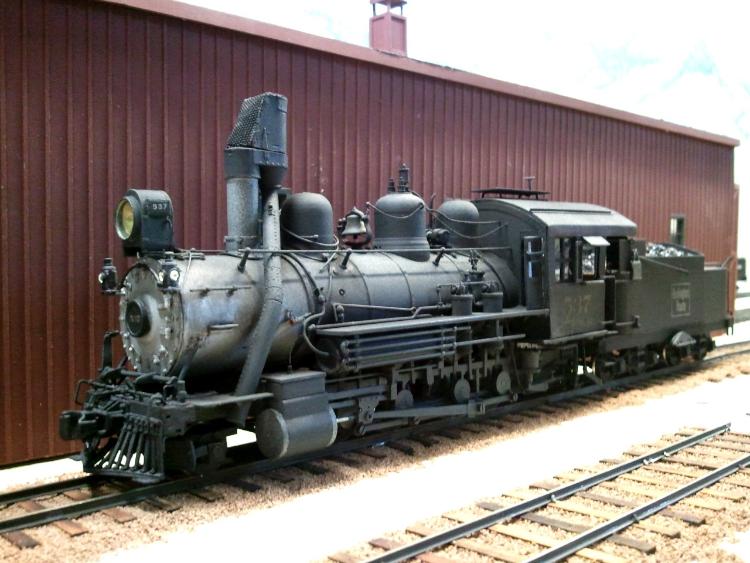
|
|
Administrator
|
This picture, the engineer's side, is in front of the Dickey Coal chutes, also built by Todd Hackett.
The backdrop was painted by Rob Smith. 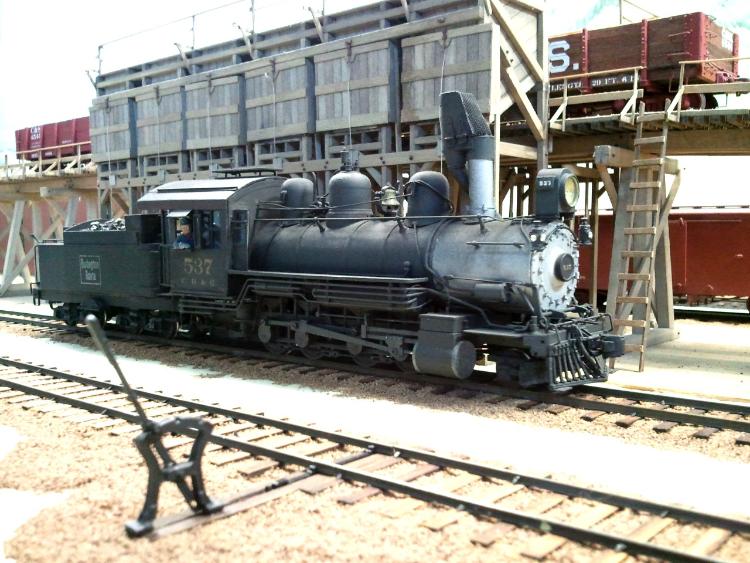
|
|
Administrator
|
In reply to this post by Mike Trent
This shot shows the relative size between #537 and #71. It is surprising how relatively small the #537 is.
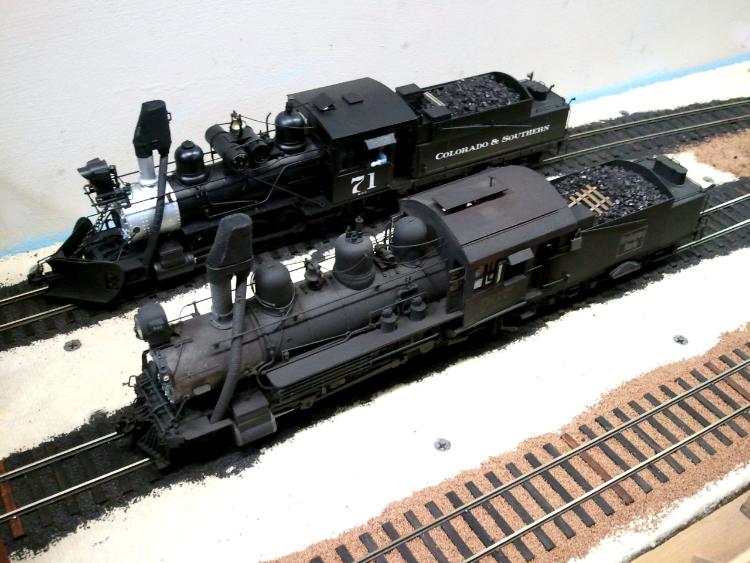
|
|
Those are awesome pictures! I need to find a junky #361 to get started on my own #537.
|
|
Mike,
Thanks for posting the photos of #537. I did not appreciate how small it is until its next to #71. Do you have a photo to compare #537 to #74? I assume #74 is larger. Again, thanks for the post. Lee Gustafson |
|
Administrator
|
In reply to this post by Mike Trent
In 1984 when this engine was built, Caboose Hobbies had a wall in their store devoted to brass castings, and I spent a lot of time there looking for anything I could find that might work for various things.
After taking what seemed like a lot of time looking for similarities between information I could get my hands on for #537 and comparing that to what I could unearth on the D&RGW C-21's, I decided that it would be possible to at least build a credible model of #537. The big thing that proves the similarities between them are the closeness of the Baldwin Construction numbers. Any reluctance I had melted away from goading by Larry Edwards and what I thought was a really good price on an old Balboa C-21 on consinment in the brass showcase. After having completely stripped and rebuilt my B-4-F engines, I was pretty well used to whacking a brass locomotive down to bits and starting over. The tender was reworked from a Precision Scale tender kit, carefully removing the flair from the rear of the tank, and using information from the C&S folio sheet for the frame dimensions. The "steel" cab was fabricated using side dimensions from #74 after reaching the conclusion that the C&S would have probably used as much of the design from the B-4-F class as possible, and I think it turned out perfect. The roof was one of those things I took a shot on from the parts wall at Caboose, and was listed as a roof for a Shay. The sand domes were also from a Lima Shay, and the steam dome was a PSC casting that I rounded by sanding. I found a PSC smokebox for something, and shortened it to extend the short Balboa smokebox. I was able to cut out a little at the bottom to reshape it to the exact diameter. The detailing was made possible by Ed Haley's most generous willingness to share photographs from his excellent collection. I had photographs from every possible angle and compared them to each other until I dreamed about them. One of the airpumps was found to be more or less handmade in the shop from parts using two halves made for air as there were no cooling fins. So two perfectly good 9 1/2 airpumps were cut up to be reborn as that cobbled up pump I saw in one of the clearer pictures. I was also able to discern the differing diameters of the steam lines that fed the pumps, and, from all the various angles I had, could, when that time came, identify every pipe as to what it was and where it came from and where it went. As previously mentioned, Hol Wagner was also of great help sharing information from his files from George Lundberg. Lundberg had retired from the C&S as Superintendant of Motive Power, and had succeeded HW Ridgway as Master Mechanic years earlier. Years after retirement, he befriended a very young Hol Wagner and shared a lot of information with him, and after he passed, left Hol his notebooks and some other information and items he had kept. Hol was also of great help to me in sharing what he knew about how #537 was probably painted in it's time on the C&S. For sure, he said, the numbers and reporting data on the cab were gold. After looking at pictures till I was nearly blind, I was sure that for most of it's time on the C&S, #537 did not have the red border around it's Burlington tender herald, and could not find any evidence that the herald on #537 was a size ever used on a CB&Q engine. But all of the C&S/Q engines we ever saw as kids were Standard Gauge. Burlington heralds were not used in the Black Hills. After scouring through various decal sets at Caboose, I found a freight car set which had a plain stenciled Burlington herald that appeared to be the correct size for #537, and Holl agreed, not only that they had actually probably used a freight car herald to make #537 look like a bona-fide "Q" locomotive, but that at that time the red borders were very rare, and were only widely used in the 40's. It is interesting that there are photos which do show the red border very late in Hol's history of #537 in the "Burlington Bulletin". But he agreed that in earlier years it clearly did not have the red border. I asked him about the red cab roof that was commonly used on both C&S and "Q" engines in the years we (and Rick) grew up with C&S in our blood, and he said that that was also rare before 1940, but that it "was possible" that #537 had a red roof. I really wanted to do it, more or less as a tribute to the C&S we grew up with as kids, but I told him I'd weather it down, to which he agreed wholeheartedly. Ironically, when Hol contacted me years later to see if I had a picture of my model for inclusion in the "Bulletin", the only one I had readily available was taken before it was finished, and you can clearly see the red cab roof. Late in '84, this engine appeared at both the Rocky Mountain Regional Convention and the National Narrow Gauge Convention, so it was seen by quite a few folks. In 1994 I sold #537 to Tom Marsh of Overland Models for use as a prototype from which a multi-scale project would be produced. Unfortunately, it was damaged in shipping, and was never repaired before Tom had a falling out with M.S Models, who built all of the C&S projects except the cabooses in On3. I was aware that he had produced some projects in Sn3, but I thought they were all ones I had worked on in the 80's. To make a long story short, Tom sold #537 to a doctor in Missouri about 10 years later, and then the Doc contacted me in 2012 to see if I wanted to buy it back. And here it is. The great thing about this hobby is that you can do pretty much anything if you set your mind to it. |
|
Administrator
|
Thanks Tim and Lee. Yes, I should have thought about that. I'll post a photo of it with #74 later.
|
|
In reply to this post by Mike Trent
Mike, thanks for sharing your model and all the information about its construction. I confess 537 has never been the object of my affection, but it is nice to see a model of it nonetheless.
Keith Hayes
Leadville in Sn3 |
Re: About the model ~ CB&Q #537
|
In reply to this post by Mike Trent
CONTENTS DELETED
The author has deleted this message.
|
|
Administrator
|
Here is a picture of #537 and #74.
The difference from ground level side by side is more striking, but you can see where #74's weight is from the much larger boiler, #537's weight is largely in the frame. By the way, it is worth noting that Bob Richardson put me on to a surviving Baldwin locomotive of this class which at the time was in El Centro, California, East of San Diego. CyZ #1 still has it's original Baldwin slope back tender. The frame and boiler is virtually identical. It has since been traded to the Iowa Central RR and Museum and is possibly going to be restored one day. When we were getting information together for the Burlington Bulletin, we used many measurements and detail photos of CyZ #1 to send to Matt Hutson, who put together a very nice drawing of #537. If you are interested at all in #537, or just looking for C&S information, I highly reccomend you search for it. as others mentioned they had on ebay earlier today in the #70 tender thread. 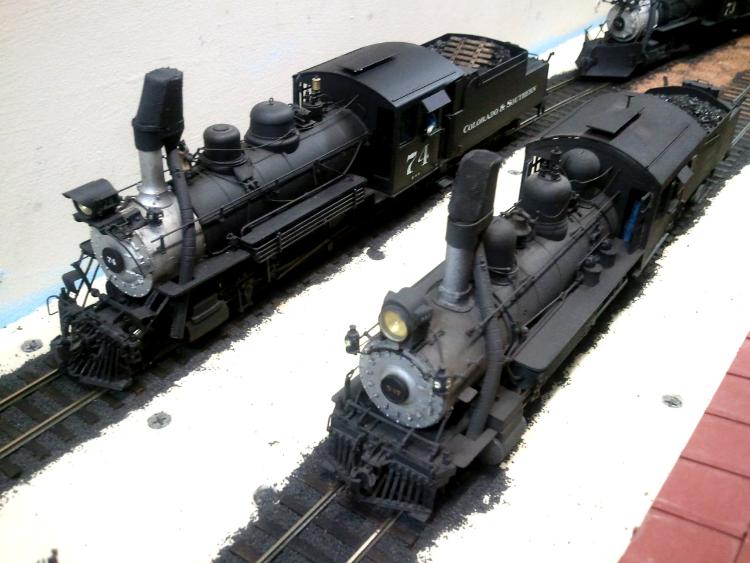
|
|
One thing that I would caution all of you folks using the Burlington Bulletin mentioned on this and the No. 70 tender post.
Although the drawing rendered in the article is nicely rendered, it is wrong. The stack on the 537 should be located directly above the cylinders, not ahead of them. On all of the Steam Locomotives that I am familiar with (and that's quite a few), the exhaust nozzle from the cylinders is located in the center of the cylinder saddle, so to maintain the proper draft, the stack is located directly above the exhaust nozzle. The only exception to this general rule is the exhaust nozzle on the Mason Bogies which swung in an arc as the cylinders moved back and forth due to the articulation of the front truck. The swinging nozzle was located under the stack. This leads me to wonder if there was an elongated petticoat above it to funnel the exhaust properly. (George???) Articulated locomotives like the 3985 are a different creature all together and without getting too technical, let us say that there are huge pipes with steam joints to take care of the problem, but once again, the exhaust nozzles (the UP Articulateds used a nozzle stand with over a dozen exhaust jets on each) are located directly below the stacks. Rick |
|
Administrator
|
Whew! Yikes, I missed that, Rick, but at least I got mine on right.
I thought you were going to rag me about that red cab roof. |
|
In reply to this post by Mike Trent
Mike that is an awesome job on 537....really has it's own look and looks beefy! As usual your attention to detail and model work is superb. Thanks for posting these photos.
William aka dgrwk37 |
|
Administrator
|
Thanks William.
Yes, especially with that extended smokebox, it really looks like a different breed of cat than the C-21's. And it really does hunker down with the brake rigging in place under the frame. I'm considering rebuilding the tender, which in my case would widen it a scale 8" to 7' 9". Now that I've narrowed the 74-76's tenders to the proper 8' width, the 537 would probably look even chunkier. At the time I built this engine, I wasn't ready to take on a tender rebuild, and the Sunset #74's tenders are way too wide. |
|
Mike, I can't help but blow smoke in your direction with your brass skills.
When building these models, and you notice a detail that is somewhat whimsical in nature do you model it as is, e.g. prototypically correct skewed Markers perhaps and suffer endless jibes as to you ability to solder straight...... or correct that detail to the normal, to avoid having to prove up all the time? I have noticed an oddity with the #537 {:))
UpSideDownC
in New Zealand |
|
Administrator
|
Hi Chris, I'm actually going to address this in a post on the subject of flaired tenders. Check over there.
|
 hmmmm.... http://digital.denverlibrary.org/cdm/fullbrowser/collection/p15330coll22/id/30843/rv/singleitem/rec/240
UpSideDownC
in New Zealand |
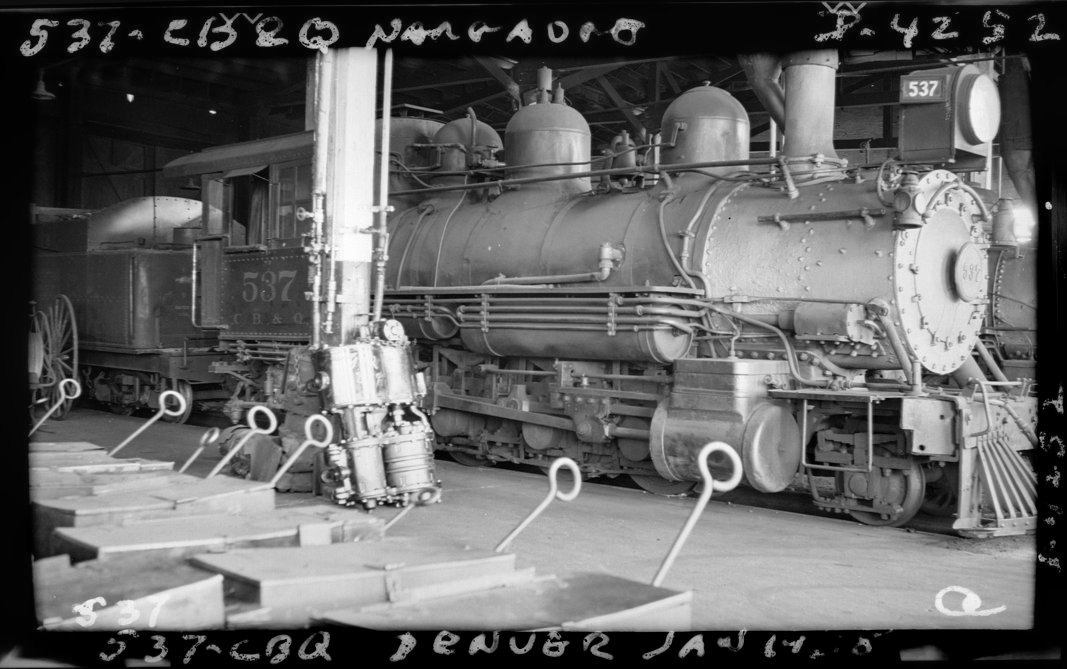
|
|
Looks like there was some pretty heavy work going on. It's not all that often that they separate the tender from the locomotive unless it's going to be out of service for some time.
The tender has to be separated as the rear of the tender is facing the locomotive cab. Neat shot, Todd. The photo says Denver Roundhouse Rick |
|
That's a really cool shot of her in the shop. I have never seen that one of her before.
|
«
Return to C&Sng Discussion Forum
|
1 view|%1 views
| Free forum by Nabble | Edit this page |

